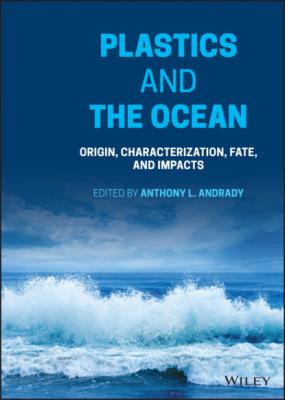Plastics and the Ocean. Группа авторов
Чтение книги онлайн.
Читать онлайн книгу Plastics and the Ocean - Группа авторов страница 37
 These are market sizes for all applications, not just in plastics.
These are market sizes for all applications, not just in plastics.
b The majority of alkylphenols (APs) found in the environment are degradation products of surfactants, not plastic additives.
c If phosphites are used, the loadings can be higher than the range indicated.
2.2 Functional Additives
2.2.1 Plasticizers
Plasticizers are added to plastics to improve their flexibility, durability, and elasticity over a broad range of temperatures while also reducing the glass transition temperature (T g) and the melt flow. The dissolved plasticizer molecules, not being covalently linked to the polymer backbone (Greco et al. 2010), can migrate freely within the resin matrix. The exact mechanism of plasticization is not fully understood; however, studies demonstrate that strong association of the polymer chains with the plasticizer molecules creates additional free volume in the bulk plastic matrix, yielding a softer and more flexible material (Greco et al. 2010; Ramos‐Devalle and Gilbert 1990).
Relatively high concentrations of plasticizers are required to achieve these desired changes in plastics, accounting for 34% of the total additives used in global plastics production from 2000 to 2014 (Geyer et al. 2017). Phthalic acid esters, or phthalates, are the most widely used plasticizers. Of the reported 8.4 million metric tons of plasticizers manufactured worldwide in 2017, about 65% were phthalate plasticizer used by the poly(vinyl chloride) (PVC) industry (IHS Markit 2018), with di(2‐ethylhexyl) phthalate (DEHP) being the most widely applied phthalates in PVC (Table 2.2). Because DEHP is highly regulated, it has gradually been replaced by diisononyl phthalate (DiNP), diisodecyl phthalate (DiDP), and di(2‐propylheptyl) phthalate (DPHP). In 2015, DPHP represented 57% of plasticizer consumption in Europe (ECPI 2016). However, the high loadings and migration of plasticizers from plastic materials have led to significant concern about the effects of phthalates in the marine environment as early as 1978 (Giam et al. 1978).
2.2.2 Flame Retardants
Plastics, especially those with a high carbon content, are inherently flammable. For many resins, the most cost‐effective method for increasing fire safety is to blend a FR additive into polymer formulations (Troitzsch and Antonatus 2021; Zweifel et al. 2001). FRs can be classified into halogen‐based, phosphorus‐based, and metal hydrate compounds. Halogen‐based FRs can vary widely in chemical structure, but the most common types are brominated organic compounds (BFRs), including polybrominated diphenyl ethers (PBDEs), hexabromocyclododecane (HBCD), tetrabromobisphenol A (TBBPA), and polybrominated biphenyls (PBBs; Figure 2.1). HBCDs are the most widely used BFRs, with 31 000 metric tons produced in 2011 (UNEP 2015).
These FRs work in the vapor or gas state and interfere with the radical mechanism of the combustion process. Plastics, such as polyethylene (PE), high‐impact polystyrene, ethylene‐vinyl acetate copolymer, and acrylonitrile‐butadiene‐styrene (ABS) copolymer, use PBDEs as FRs (Andrady and Rajapakse 2019; Delva et al. 2018; Rahman et al. 2001). Recently, many PBDEs, such as penta‐BDE, octa‐BDE, and deca‐BDE, have been phased out due to their significant persistence and toxicity. New BFRs, such as 1,2‐bis(2,4,6‐tribromophenoxy) ethane, have been developed as substitutes (Sun et al. 2019). Phosphate‐based FRs, such as tri(2‐chloroethyl) phosphate (TCEP) or tris(2‐ethylhexyl)phosphate are char formers that produce phosphoric acids that react with the substrate to generate a char that protects the polymer itself from combustion (Ambrogi et al. 2017; Samani and van der Meer 2020). Metal hydrate FRs are typically aluminum trihydroxide and magnesium hydroxide that hydrates decompose under high heat to release water, preventing propagation (Innes and Innes 2002).
Table 2.2 Eight of the most commonly used phthalate plasticizers in PVC.
Source of data: Zero Breast Cancer. (2014). “Phthalates: The Everywhere Chemical.” Retrieved October 8 2020, from https://www.niehs.nih.gov/research/supported/assets/docs/j_q/phthalates_the_everywhere_chemical_handout_508.pdf.
| Name | Abbreviation | Common metabolites | Banned in toys and childcare articles in EU | Banned in U.S. toys or childcare articles |
|---|---|---|---|---|
| Butyl benzyl phthalate | BBP | Mono benzyl phthalate (MBzP) | X | X |
| Di‐n‐butyl phthalate | DnBP | Mono‐n‐butyl phthalate (MnBP); mono‐isobutyl phthalate (MiBP) | X | X |
| Di‐(2‐ethylhexyl) phthalate | DEHP | Mono‐(2‐ethylhexyl) phthalate (MEHP); mono‐(2‐ethyl‐5‐hydroxyhexyl) phthalate (MEHHP); mono‐(2‐ethyl‐5‐oxohexyl) phthalate (MEOHP); mono‐(2‐ethyl‐5‐carboxypentyl) phthalate (MECPP) | X | X |
| Diethyl phthalate | DEP | Monoethyl phthalate (MEP) | ||
| Di‐isodecyl phthalate | DiDP | Mono‐(carboxynonyl) phthalate (MCNP) | X | |
| Di‐isononyl phthalate | DiNP | Mono‐isononyl phthalate (MiNP) | X | X |
| Di‐n‐hexyl phthalate | DnHP | X | ||
| Di‐n‐octyl phthalate | DnOP | Mono‐(3‐carboxypropyl) phthalate (MCPP); mono‐n‐octyl phthalate (MOP) | X |
Note: Several phthalates have been banned by the European Union (EU) or the United States for use in toys or childcare articles at concentrations >0.1% (ZBC 2018).
Figure 2.1 Chemical structures of (a) PBDE, (b) HBCD, (c) TBBPA, and (d) PBB.
FRs have a high propensity to migrate out of the plastic into surrounding environments. Some FRs are used as mixtures of congeners, such as commercial PBDEs, with certain congeners more toxic than others. Although some commercial PBDEs (penta‐BDE, octa‐BDE, and deca‐BDE) have been phased out (Sharkey et al. 2020), they will remain in the environment for many years because of their persistence.
2.2.3